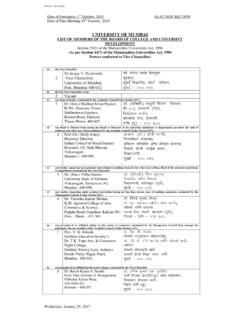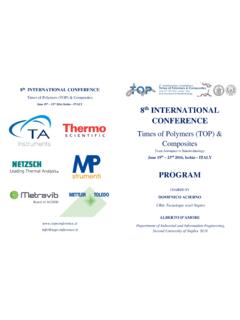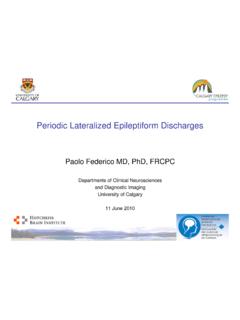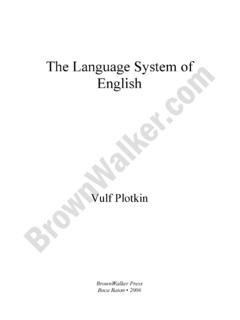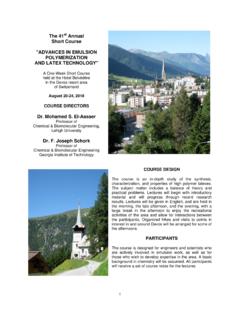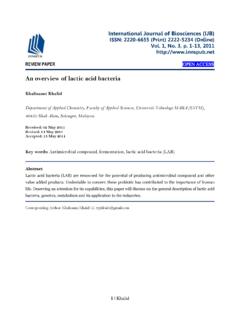Transcription of 4. 114 M.Sc. Life Science - Mu
1 AC 6 6 12 Item No. UNIVERSITY OF MUMBAI. Syllabus for the Sem. I & II. Program: Course: life sciences (Credit Based Semester and Grading System with effect from the academic year 2012 2013). 1 Revised Syllabus of Semester I and II life sciences SEMESTER I (60 lectures: Credits 4) PSLSC101: Biodiversity, Evolution, Environmental Biology and Environmental Technology UNIT I: Diversity and Systematics (15 lectures)) Changing perspectives in understanding diversity from morphology / anatomy / physiology / biochemistry to immunology, genetics, genomics and proteomics, methods of identification of biodiversity. Molecular systematics. UNIT II: Evolution (15lectures)) 1. Origin of life : Classical experiments current concepts, evolution of biological macromolecules.
2 2. Natural Selection: Darwinism, its critical review and modern theory of evolution 3. Human evolution 4. Genetic basis of evolution UNIT III: Environmental Biology ((15lectures)) 1. Ecosystems: Basics features / types, energy flow in ecosystems, ecological productivity ecosystem modelling and systems approach to resource management and conservation. 2. Renewable energy and biofuels. Environmental health: Environmental stress and adaptations, Effect of pollutants on living. Systems, their interactions at cellular and molecular levels molecular epidemiology, mutagenecity, genotoxicity, carcinogenicity, human disorders related to environmental pollution, biomonitoring indicators, bioremediation of pollution.
3 4. Toxicology: Basic principles of toxicology including LD50and ED50, management of acute intoxication, natural detoxification biochemical and genetic mechanisms. 2 UNIT IV: Environmental Technology (15lectures) 1. Sources, generation, classification & composition of solid wastes. Solid waste management methods Sanitary land filling, Recycling, Composting, Vermi composting, Incineration, energy recovery from organic waste. 2. Solid Waste Management Plan, Waste minimization technologies, Hazardous Waste Management, Sources & Classification, physicochemical properties, Hazardous Waste Control & Treatment. 3. Sun as a source of energy, solar radiations and its spectral characteristics, fossil fuels classification, composition, physico chemical characteristics and energy content of coal, petroleum and Natural gas.
4 4. Principles of generation of hydroelectric power, tidal power, thermal energy conversion, wind, geo thermal energy, solar collectors, photovoltaic, solar ponds, oceans. PSLSC102: Cell , Micro & Molecular Biology UNIT I: Cell biology and Immunology (15lectures) (25 lectures) 1. Cell as a macromolecular assembly, cellular compartmentalization and organelle architecture. 2. Nucleosome, chromatin and chromosome structure, nucleic, acid . protein interactions: histones and non histones, topoisomerases, helicases and DNA binding proteins. 3. Basic & cellular immunology : Types of immunity & immune response, lymphoid organism structure and classes antibodies, antigen and antibody reactions, complement system, histocompatubility antigens (MHC) and their role in antigen presentation & cytotoxicity, cell adhesion molecules & their role in immunity.
5 UNIT II: Microbiology (15lectures) 1. Bacteriology Morphology and ultra structure of bacteria morphological types cell walls of archaebacteria, Gram negative 3 and Gram positive eubacteria, Eukaryotes, L forms. Cell wall synthesis, antigenic properties, Capsule types, composition and function, Cell membranes structure, composition and properties. 2. Virology Discovery, nomenclature, classification and general characters of viruses, Distinctive properties of viruses, Morphology and ultra structure, capsids and their arrangements, types of envelopes and their composition. Viral genome, their types and structures, Virus related agents Viroids and prions. 3. Mycology: Classification and general features of fungi.
6 life cycle of Penicillin, Saccharomyces and Fusarium. Structure of fungal cells and growth Hyphae and non motile unicells, motile cells, effect of environment on growth, prevention of fungal growth. 4. Phycology: Distribution of algae, Classification of algae, Algal nutrition, reproduction, green algae, diatoms, euglenoids, brown Rhodophyta, Microalgae. UNIT III: Molecular Biology (15lectures) (50 l )1. Basics of gene structure, split genes, introns/exons and overlapping genes. 2. Eukaryotic genome complexity : C value paradox, Cot analysis and estimation of coding potential repetitive / satellite DNA, Gene clusters, pseudogenes, global view of genome organization (comparative genomics0 in prokaryotes and eukaryotes.)
7 3. DNA replication and its regulation, telomere replication. 4. DNA mutagenesis, repair and recombination (homologous, site . specific and illegitimate), transposons and retotrasposons. 5. Functional organization of genes in eukaryotes: promoters, operators, enhancers, control elements, Open Reading Frame (ORF), operons, terminator regions, genes for mRNA, tRNA & rRNA and their independent RNA polymerases. 6. Global view of gene expression and its regulation at various levels, gene imprinting. 7. Membrane receptor interactions : G protein coupled receptors, tyrosine kinase receptors, ser thr kinase receptors and cytokine receptors structural features of transmembrane receptors, hormone.
8 Receptor interaction. 4 8. Signal transduction: Two component signalling in prokaryotes, basic concepts in eukaryotic signalling role of phospoinositides, ion channels and second messenger, representative signalling pathways and their role in metabolism (eg. Peptide hormone), development (eg. Steroid hormone) neuronal transmission, cell cycle control & apoptosis. UNIT IV: Molecular Microbiology (15lectures) 1. Functional organization of genes in prokaryotes 2. Prokaryotic genome constitution 3. Specialized cloning strategies Expression vectors, promoter probe vectors, vectors for library construction artificial chromosomes. 4. Rationale for the design of vectors for the over expression of recombination protein, selection of suitable promoter sequences, ribosome binding sites, transcription terminator, fusion protein tags, purification tags, protease cleavage sites and enzymes, plasmid copy number and inducible expression system.
9 PSLSC103: Measurements and Techniques in Biology UNIT I: Biostatistics I (15lectures) 1. Introduction, scope, applications and uses of statistics, collection and classification of data, census and sampling surveys, graphs and diagrams, central tendency and its measures : arithmetic mean, median, dispersion and its measures : range and its coefficient, variance and standard deviation, coefficient of variation. 2. Bivariate data, scatter diagram and interpretation, calculation and interpretation of Karl Pearson's correlation coefficient, equation of the lines of regression and properties of regression lines. 3. Probability, definition, addition and multiplicative laws (without proof).
10 Random variable and its distribution, binomial probability distribution, examples and conditions, means and variance, Poisson probability distribution, examples and conditions, means and variance, continuous variable, normal distribution, use of normal probability table for finding probabilities. 5 4. Population parameters and sample statistics, sampling techniques: simple random sampling, stratified random sampling, systematic sampling, standard error 5. Estimation: point & interval, Estimators of population mean & proportion (without proof), confidence intervals for population mean & proportion. 6. Testing of hypothesis: Hypothesis and its types, errors and its types, levels of significance, one tailed.





